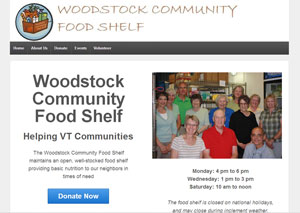 Vermont’s strength is a direct result of the strength of the community organizations that step up in time of need, or provide ongoing assistance to members of the community in need. While these organizations are often small and cover only a few towns, it is still beneficial for them to have a web presence that allows them to accept online donations, spread relevant information to the communities they serve and to simply be found by others who want to help. This is especially true for local food shelves.
Vermont’s strength is a direct result of the strength of the community organizations that step up in time of need, or provide ongoing assistance to members of the community in need. While these organizations are often small and cover only a few towns, it is still beneficial for them to have a web presence that allows them to accept online donations, spread relevant information to the communities they serve and to simply be found by others who want to help. This is especially true for local food shelves.
Thanks to help from the Vermont Digital Economy Project and web developers from Code for BTV, two more community food shelves, the Woodstock Food Shelf and the Bethel Food Shelf now have a web presence. Through the use of online tools the two organizations will be able to bolster donations and improve communications with those who might need their services.
In the aftermath of Tropical Storm Irene, donations and support came into the state from all over America. People who had heard about the devastation on the news looked online for Vermont organizations involved in the recovery effort to donate to. These donations to small Vermont organizations and towns were instrumental in helping to rebuild faster and get aid to those who needed it most.
Some helpful Vermont nonprofits, however, were not able to fully capitalize on this influx of donations from across the country. Without a website or online presence, very few people outside of Vermont recognized that the Bethel Food Shelf was helping out more people than ever before after Irene, running extra hours, serving hot meals, and in need of as much food as people were willing to donate. At the time of the flood, the Bethel Food Shelf had $129 in its bank account.
For the Woodstock Food Shelf, it was the same story: with power outages and homes and roads destroyed, the food shelf was helping families get back onto their feet, but few people knew about it. Some donations did come from afar thanks to former residents, but for individuals across the country, donating to the either the Bethel or Woodstock Community Food Shelf required finding an address and mailing a check. A web presence for these organizations during such a disaster might have helped them to receive more donations, gain more attention, and spread the word about their services.
Even outside of disasters, food shelves are an integral part of the support system for Vermonters in need. According to the Vermont Foodbank, community food shelves serve as many as 86,000 Vermonters each year. Building the capacity of the local food shelf is, in effect, building the capacity of the community to take care of itself. However, these organizations need support, both for in terms of food and monetary donations, as well as volunteer labor. The Bethel Foods Shelf and the Woodstock Community Food Shelf hope their new websites will bring in additional resources.
Volunteers with the Woodstock Community Food Shelf discuss their new website
According to Laura Kent, Board President of the Woodstock Community Food Shelf, “There are so many big-hearted people in our community who want to help out – this website allows those generous souls to find the WCFS and donate both food or funds. They don’t need to pick up a phone to find open hours, or where to send a check – it’s all in one easy spot on our website.”
Having a web presence also assists the food shelves in getting the word out about special needs. Each month the Bethel Food Shelf will be putting on their website a food wish list.
“We try to work through the church and have a monthly collection for food and for money. But, with a website, I think it would be instantaneous. They would know if we need tuna fish, peanut butter, whatever could not be purchased through the Foodbank and that would offer us a better amount of things to offer the people that came in,” said Mary Ann Church, a volunteer with the Bethel Food Shelf. “I think the website will not only awaken people to what we have that they could come and use, but also bring in people who have the means to help us, and help others.”
An online presence can also be helpful for spreading the word about the services offered. According to Kent, “Those who need food assistance can also find out how and when to reach the Food Shelf. If someone is experiencing a rough patch in his/her life, then all he or she needs to do is visit our website to find when and where to receive food. There’s no need to search for a phone book, call information, or ask around town. Finding us through the website is easier and far more private.”
Kent is ecstatic about the new website. “The Woodstock Community Food Shelf website is an invaluable tool for both those giving and receiving food assistance. A great resource for all!”
Each month, the VT Digital Economy Project, in conjunction with volunteers from Code for BTV, select one or two nonprofits for a website overhaul.
